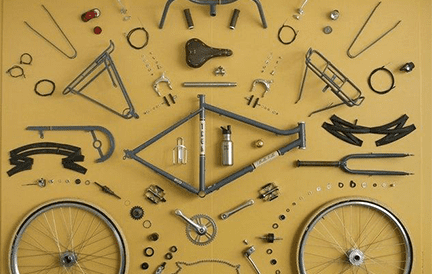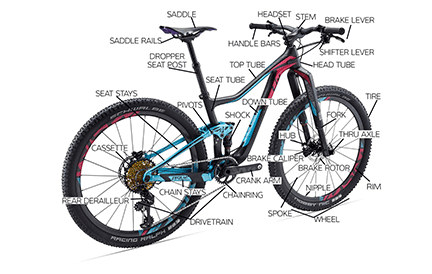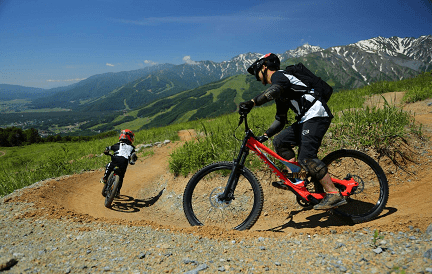An MTB shock pump is required to keep the suspension in good condition and to provide comfort while riding. Shock pumps will tune your suspension air to balance your suspension, allowing you to ride more comfortably, especially on rougher terrain.
- Part 1: What does a Shock Pump do
- Part 2: Things to Consider When Purchasing a Mountain Bike Shock Pump
- Part 3: 5 MTB Shock Pumps that Might Be Perfect For You
- Part 4: Comparison of Advantages and Disadvantages of Each Shock Pump
- Part 5: Summary
Part 1: What does a Shock Pump do
A shock pump fills the air chamber of a shock to a pressure appropriate for the rider’s weight, preferences, and the terrain on which the bike is used. Because the air chambers in bicycle suspension systems are small and operate at high pressure, shock pumps are designed to move little air. It also includes measuring gauges that display the shock pressure in pounds per square inch (PSI). It would be impossible to accurately adjust the tension without the feedback provided by the gauge, and it is also compact enough to fit in a backpack.

Other than that, Shocks lose air significantly slower than tires. Therefore, you don’t have to pump the suspension for as long, once you’ve found the right settings for you. If you’re going on a long tour and your bike has air suspension, a shock pump in your kit might come in handy.
Now that you know what a shock pump is and what it does, we’ll help enlighten you on some things you might want to consider when purchasing an MTB shock pump for your bike.
Part 2: Things to Consider When Purchasing a Mountain Bike Shock Pump
The ideal MTB shock pump, as we all know, is determined by the rider’s weight, preferences, and the terrain on which the bike will be used. So here are some things you might want to think about, and we’ll go over them one by one.
Gauge
The gauge will show how much pressure you will apply to your bike. To ensure accuracy, use a quality gauge with readable print and a long needle. To determine the efficiency of a gauge, use the sag measurement system. However, you might want to avoid shock pumps with small and difficult-to-read gauges because they may work adequately, but the small display makes them inconvenient.
Handle
Some mountain bike shock pumps have a slick handle that makes pumping difficult and uncomfortable. A mountain bike shock pump with rubber handles or something similar, on the other hand, will provide a more ergonomic grip for comfort and stability when inflating.
Body
If you’re planning a multi-day adventure, you should look for a pump that’s small and compact enough to fit in your pack or not being too heavy. Aside from that, the body of a MTB pump determines its durability and portability. As a result, look for one with sturdy construction, such as those made of aluminum. It is not only more durable, but it is also resistant to corrosion and, of course, lightweight.
Hose
Mountain bike shock pumps with longer hoses simply have more surface area for grip, which is useful most of the time because more surface area means less force is required when pumping. Aside from that, a shock pump with a flexible hose that can deliver higher pressure is preferable.
Valve Head
Most high-quality mountain bike shock pumps include a valve to ensure that no air is lost from the suspension air chamber and remains in the suspension fork after the pump is removed.
Bleed Valve
The best MTB shock pump has a single button that controls how much inflated air is used to tune and balance your suspension for a comfortable ride. When there is too much air in the suspension, a shock pump with a bleed valve will automatically adjust the suspension to the ideal level.
Display
It is entirely up to you whether to purchase an analog or digital shock pump display. Some people still prefer analog displays, despite the fact that they are more expensive and It’s more difficult to read if you’re trying to be precise, because forks use relatively low pressures, making accurate readings critical. Meanwhile, a digital display is usually easier to read, precise, and often has more features. However, the display requires batteries, and batteries run out quickly, especially if stored in a freezing pack. So, bringing a highly accurate pump is pointless if it doesn’t work, leaving you guessing.
To sum it up, analog is more suitable for trail use, while digital is suitable for workshop tuning.
Part 3: 5 MTB Shock Pumps that Might Be Perfect For You
Below is a list and introduction to 5 MTB shock pumps that you should consider purchasing:
RockShox 300 PSI
It is one of the most commonly used pumps and has been rebadged by a variety of different brands. The RockShox shock pump provides 300 PSI of air pressure support, which should be sufficient for all types of suspensions. It is ideal for maintaining your bicycle’s shock absorbers because it delivers high pressure at low volumes for precise calibration of your rear suspension and air fork. It has a sturdy metal housing and delivers a sleek, accurate, straightforward package. Weighing just over 200 grams, the analog display is 208.8 grams and the digital display is 216.3 grams. It is available in both analog and digital displays for $50 and $76. The bleed valve assists you in obtaining accurate measurements by allowing excess air to escape when you over-pump. Lastly, it includes a valve head.
Birzman Macht
Weighing only 85 grams, Birzman Macht is one of the lightest mountain bike shock pumps on the market, due to the use of aluminum alloy in the pump’s structure and slim design. This enables Birzman Macht to become as efficient and long-lasting as most mountain bikers want their shock pumps to be. It can be thought of as a cross between a standard-sized pump and an emergency pump capable of producing 300 PSI of air pressure. Priced at $55, it comes with an analog display.
Lezyne Digital Shock Drive
This one is clearly designed for someone looking for portability, as it costs $92 and weighs only about 108 grams. The Lezyne Digital Shock Drive can produce 350 PSI of air pressure and comes with a large digital display and a toggle located between the BAR and PSI that covers the various pressure units used in different regions. It has a hose that can rotate 360 degrees and a pressure relief bleed valve that easily releases air if you over-pump, allowing you to achieve the desired pressure.
Topeak Pocketshock DXG
The Topeak Pocketshock DXG is a relatively small and lightweight pump weighing 174.9 grams, making it ideal for use in a backpack while still providing a reasonable pumping output. It’s no surprise that all types of mountain bike riders use it. It is also reasonably priced for a standard-sized pump, at $50 with an analog display. It can produce up to 360 PSI of air pressure, and the rotating hose makes it simple to connect the pump to the rear shock valve. The pump has a Pressure Rite connector valve to eliminate air loss during pumping and disconnection, but you must always ensure that the control ring is unscrewed far enough before connecting and disconnecting the pump head. Otherwise, you may experience pressure loss.
SKS SAM
This 400 PSI analog pump has a two-stage threaded connector that attaches to the valve without opening it, allowing you to secure it before opening the second stage and valve to allow the pump to operate. SAM stands for Suspension Air Mechanic. It reduces the likelihood of air blasting out when attaching or removing the valve while adjusting pressure. It weighs 278.3 grams and costs $55.
Part 4: Comparison of Advantages and Disadvantages of Each Shock Pump
Now, we’ll go over the advantages and disadvantages of each MTB shock pump on the list above in greater depth:
RockShox 300 PSI
Advantages
The RockShox 300 PSI is definitely sturdy, and the metal housing can withstand the abuse it will inevitably receive in the workshop. It is very easy to pump, and mountain bike riders can easily read the PSI and bar units. The pump hose can rotate 360 degrees, making it easy to use in all positions, not to mention the comfortable handle that comes with it. Another feature that adds to its benefits is a valve head that prevents air loss during disconnection. It is slim and portable in terms of design. Last but not least, if you want the one with an analog display, it is reasonably priced.
Disadvantages
Though it is very comfortable to pump with, the analog display gauge is not very accurate, and you must be careful not to accidentally press the bleed valve button. Furthermore, the one with a digital display is not cheap, and it is a little too long for portability.
Birzman Macht
Advantages
It is compact and light, with an air-lock valve head that prevents air loss. In addition to that, it is also strong and long-lasting due to its aluminum construction.
Disadvantages
Despite its small size, it is not the most accurate pump on the market. Its compactness also results in a smaller pump, making it more difficult to use. It also produces less output. However, it would be a good choice for someone who values compactness.
Lezyne Digital Shock Drive
Advantages
As previously stated, the Lezyne Digital Shock Drive is compact, accurate, and has a large digital display that is easy to read, as well as a battery level indicator that tells you when the battery is running low. It’s also worth noting that because the hose attached to the pump can rotate 360 degrees, it’s easier to use in any position. Finally, despite its small size, it produces excellent output.
Disadvantages
Despite the fact that it has a large digital display, it is not very accurate. Besides that, the digital display requires batteries, whereas the Lezyne Digital Shock drive only requires a CR 1220 battery with a 35 mAh capacity due to its compact design. Therefore, the battery will not last long. Moreover, given the relatively small size, the pump head is large and slippery, making it difficult to screw. On top of that, with all of the features that come with it, the price you must pay will not be cheap.
Topeak Pocketshock DXG
Advantages
The Topeak Pocketshock DXG has a display that is not only accurate but also easy to read. It also has a bleed valve for increased accuracy. Its design is sleek, with a smooth pump head that is also durable. The price is reasonable too.
Disadvantages
It doesn’t have many flaws, but due to its small size, increasing air pressure takes a lot of strokes.
SKS SAM
Advantages
The SKS SAM is user-friendly because it provides high-pressure output and has an ergonomic design that is simple to use. It also comes with a two-stage valve, which is useful for reducing accidental pressure loss. And, despite its low price, its gauge is quite accurate.
Disadvantages
Its bulky figure fits comfortably in hand but is too large and heavy to fit in a backpack. Not to mention its short hose, which makes it unsuitable for use on the trail.
Part 5: Summary
A shock pump is essential for any mountain bike rider, whether they are beginners or experts. Whether you prefer an analog gauge because it is less expensive or a digital gauge because it has more features, no matter which shock pump you choose, there are many quality designs available to meet your needs. Nevertheless, a high-quality shock pump will undoubtedly improve your trail riding experience.









